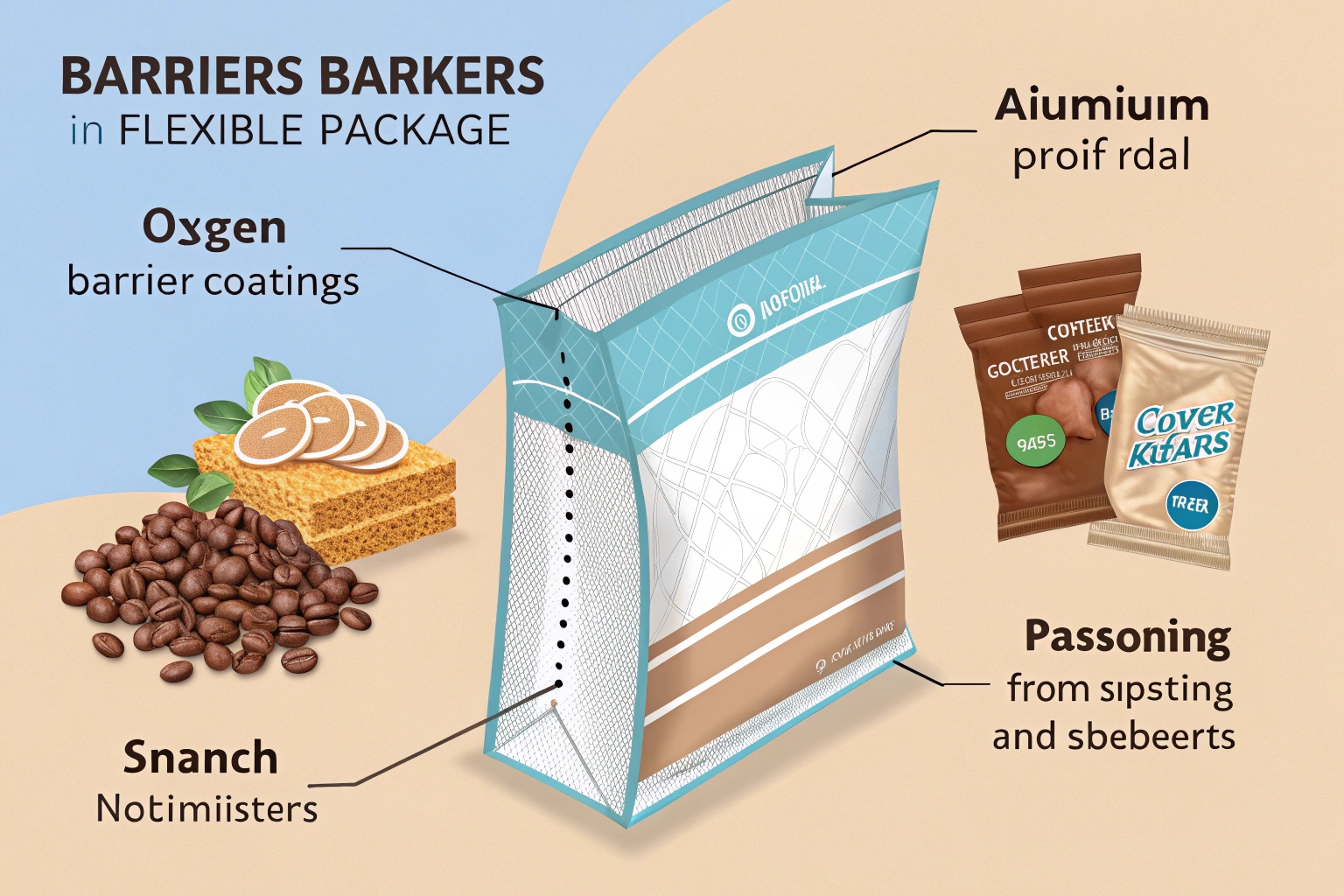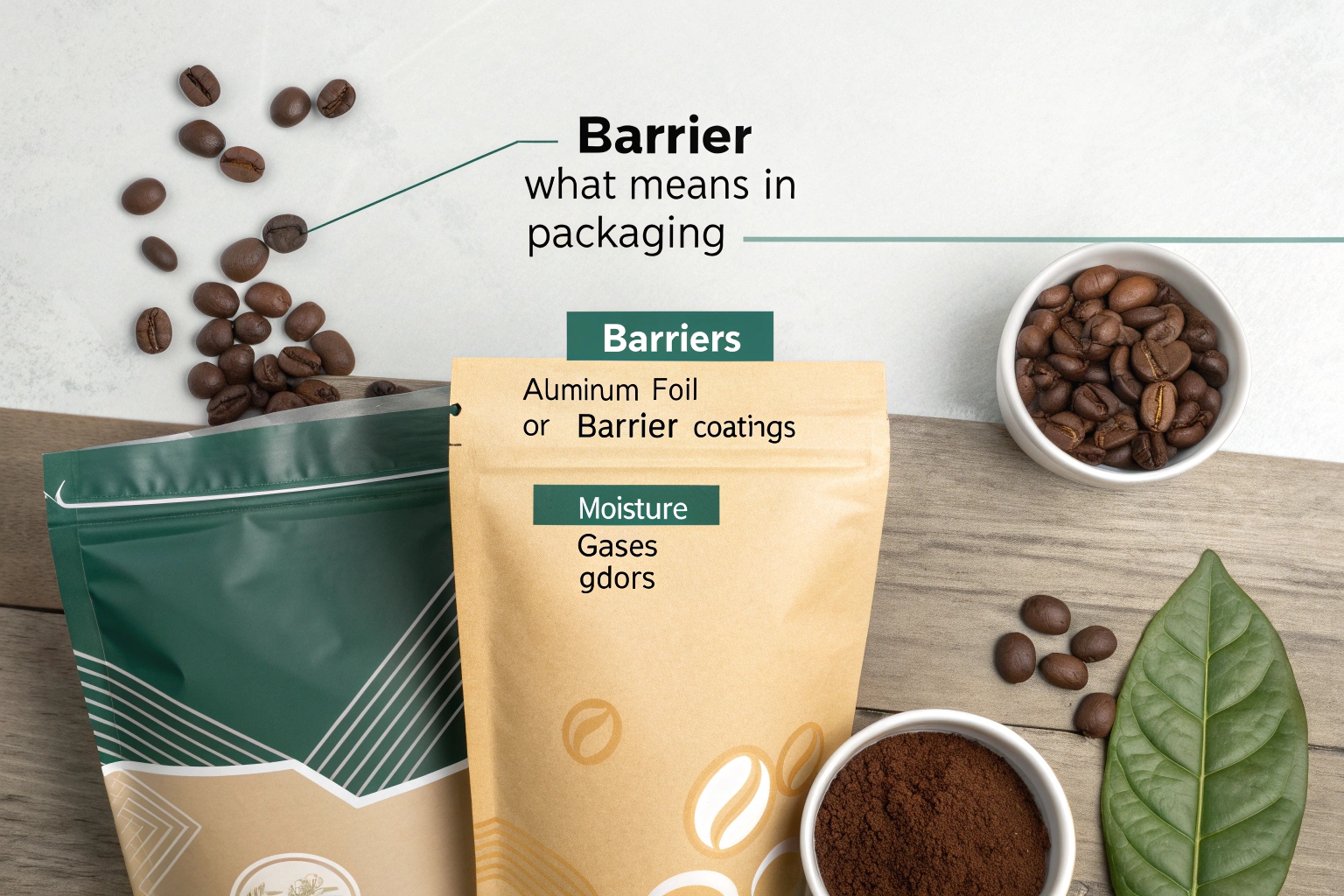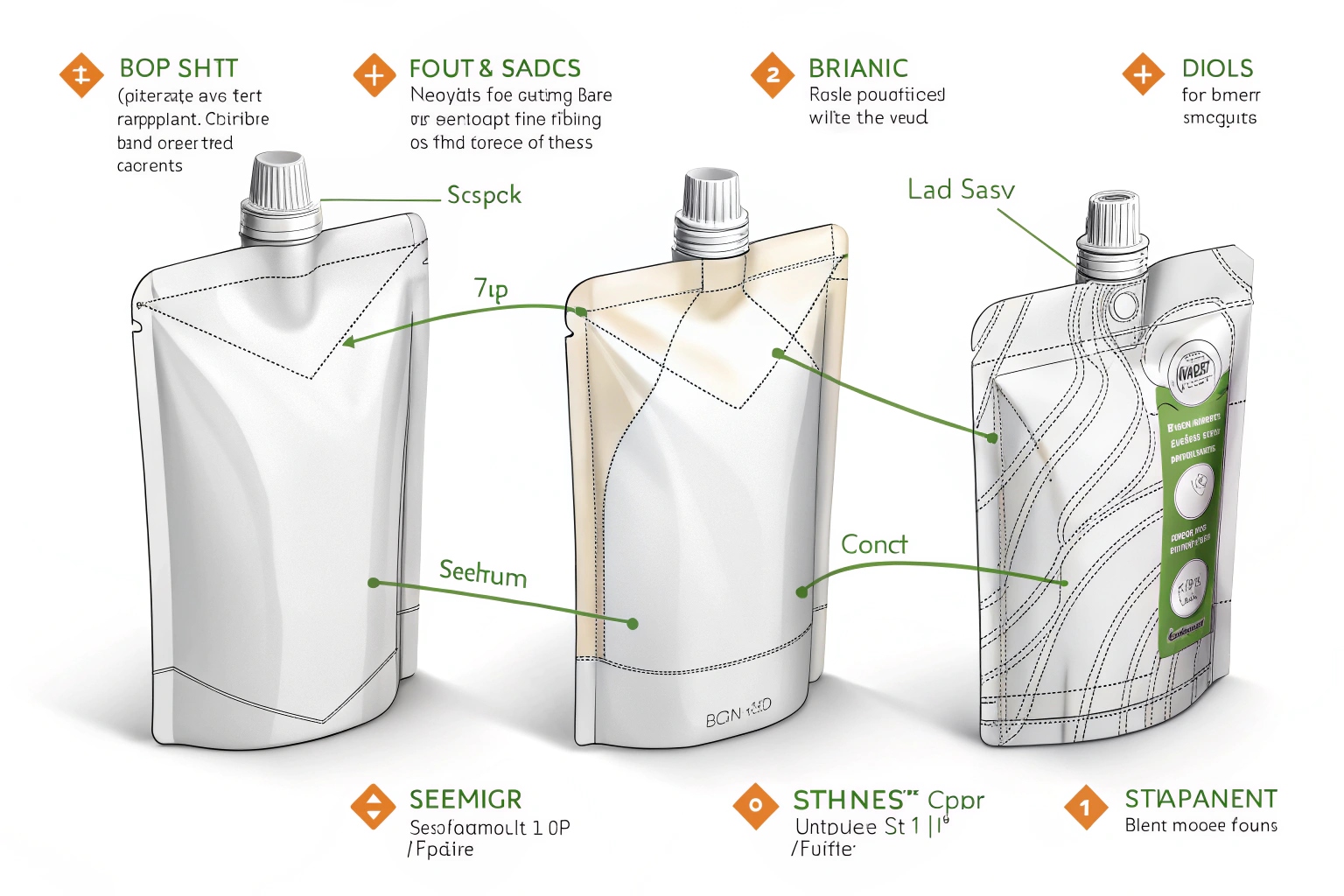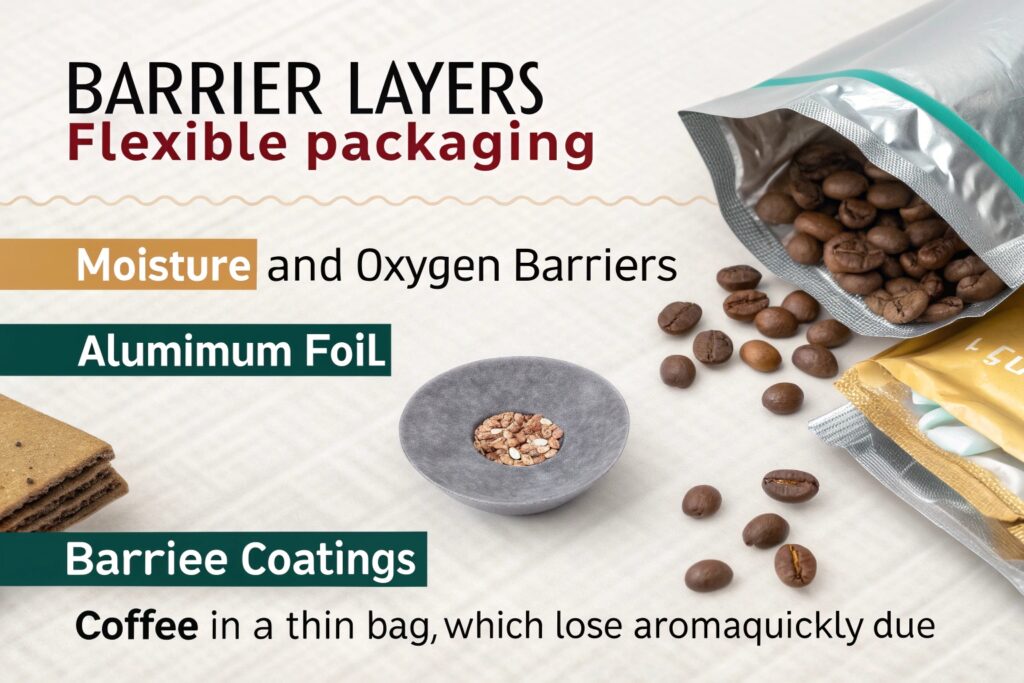I worried that my products might go stale or leak through a thin bag.
Yes. Bag thickness directly affects barrier strength, shelf life, and durability. Thicker material usually protects better.
That got me thinking. I needed to know why, how much, and what trade‑offs were involved. Let’s dig deeper.
What are the barriers in flexible packaging?
I wondered what “barrier” really means in packaging.
Barriers are layers like plastic, foil, or coatings that stop moisture, gas, light, or odor passing through the bag.
I once stored coffee in a thin bag. It lost aroma fast. I learned how important each barrier layer is.
Dive Deeper: Understanding barrier types
Moisture and oxygen barriers
- Materials like aluminum foil1 or barrier coatings stop oxygen and water vapor.
- Water‑sensitive products like snacks or coffee need strong moisture barriers.
- Oxygen‑sensitive items like chips or pharmaceuticals need layers that block gas exchange.
Light barrier
- Light, especially UV, can degrade color, flavor, or nutrients.
- Aluminized film or printed inks help block harmful light rays.
- Dark packages or opaque layers protect light‑sensitive goods like oils or chocolates.
Aroma and odor barrier
- Some plastics let smells pass through, which hurts both product and outside aroma.
- Adding nylon or EVOH2 helps keep aromas in and foreign odors out.
Combining barrier effects
- A single layer rarely handles all threats.
- Multiple layers combine strengths: e.g., an inner seal layer, then EVOH2 for gas, then aluminum for light and moisture.
- Each layer has one main job, but together they build full protection.

What is thickness in packaging3?
I asked myself, what counts as thickness?
Thickness means how many micrometers (µm) or mils the film or laminate is. Thicker films resist punctures, tears, and slow down barrier diffusion.
I once tested two samples: one thin (50 µm) and one thick (150 µm). The thick one survived rough handling and kept product fresh much longer.
Dive Deeper: How thickness influences protection
Strength and puncture resistance4
- Thicker layers resist punctures, tearing, or edge damage. That’s vital in transit or when sharp objects touch the bag.
- Thin films rip easily. A simple missing corner can ruin a product batch.
Slowing diffusion
- Molecules like oxygen or moisture pass through material slowly. More distance (thicker film) means slower leak.
- For sensitive products, a thicker barrier layer prolongs shelf life noticeably.
Sealing integrity
- Very thin films may seal unevenly, leading to weak points.
- Thicker films hold heat better during sealing, forming strong, uniform seals.
Handling and machinability
- Too thin leads to wrinkles or jams in packaging machines.
- Too thick can reduce equipment speed or increase wear.
- Finding balance is key: enough thickness for strength, but still machine-friendly.

How many layers minimum are used in a flexible packaging?
I kept wondering: what’s the smallest number of layers that still works?
Minimum is typically three layers: a sealant layer5, a barrier layer, and an outer print/protection layer.
I overheard a supplier say: “At least three layers or you risk failure.” That stuck with me.
Dive Deeper: Why at least three layers?
1. Sealant layer (inner)
- Touches the product and heat‑seals. Often PE (polyethylene) or PP (polypropylene).
- Needs good bonding and heat sealing properties.
2. Barrier layer (middle)
- Provides protection: materials like EVOH2, aluminum foil1, or metallized PET.
- EVOH2 is excellent for oxygen; aluminum is best for moisture and light.
3. Outer layer
- Adds strength, print surface, and scratch resistance. Commonly PET or OPP.
- Carries branding design and protects inner layers.
Why not fewer?
- 2-layer films fail to balance all needs: e.g., a PE + barrier without outer layer exposes barrier film directly to damage.
- Three layers each serve a unique purpose—removing one risks product quality or packaging integrity.
Additional layers for extra functions
- Tie layers help adhesion between incompatible plastics (e.g., PE and PET).
- Adhesive or primer layers improve print or coating adhesion.
- Extra functional layer for things like printable surfaces, cold seal, or anti-fog.

What are the disadvantages of flexible packaging?
I asked: if flexible packaging is so useful, what are its downsides?
Flexible packaging has limits: it can be vulnerable to heat, has recycling challenges6, and may not protect heavy or sharp contents well.
I once switched from rigid bottles to pouches. They were light, but some bursts occurred in hot trucks.
Dive Deeper: Listing disadvantages
Heat and high‑temperature sensitivity
- Some films warp, melt or lose seal strength in hot storage or transport.
- Thicker doesn’t always mean better; certain plastics soften easily.
- For hot climates, we must choose temperature‑stable materials or add protective outer layers.
Mechanical damage risk
- Sharp edges or heavy weight can still puncture multi‑layer films.
- Even thick films get pierced by metal rims or clips.
- Using puncture‑resistant layers (e.g., nylon) helps, but adds cost.
Environmental and recycling concerns
- Multi‑layer laminates are hard to recycle—they mix incompatible materials.
- Often end up in landfill or incinerator unless specially processed.
- Many brands struggle to offer eco‑friendly flexible packaging.
Cost and complexity
- More layers and thickness increases material cost and processing complexity.
- Manufacturing requires expensive lamination or coating equipment.
- For low‑margin products, the added cost may hurt budget.
Machine performance issues
- Very thick or multi‑layer films may run slower on packaging lines.
- They need adjusted machine settings—heat, tension, speed—to avoid wrinkles or misfeeds.
- That means more calibration time and risk of downtime.
Barrier aging and shelf‑life uncertainty
- Some barrier materials like EVOH2 lose performance in high humidity or over time.
- Thicker film slows aging, but doesn’t stop it.
- Testing under real‑world conditions is essential.
Consumer perception
- Some customers see flexible pouches as less premium compared to rigid containers.
- Depending on product, a pouch may feel “cheap” or “fragile.”
- Brands must design tactile or visual cues (like matte finishes or elevated print) to signal quality.
Conclusion
Thickness of flexible packaging matters a lot. It boosts strength, barrier performance, and longevity.
But thickness must balance machine handling, cost, and product needs.
Barriers—like foil, EVOH2, or nylon—are layers that protect against moisture, gases, light, and odors.
Thickness slows diffusion and resists damage.
At minimum, flexible packaging uses three layers: sealant, barrier, and outer. More layers add function but raise cost and recycling issues.
Disadvantages include sensitivity to heat, mechanical damage risk7, recycling complexity, cost, and consumer perception8.
Choosing right film means weighing these trade‑offs. I learned this through trial, supplier talks, and many tests.
Now I consider thickness, layers, cost, and end‑use together before picking a flexible packaging solution.
-
Find out how aluminum foil serves as an effective barrier in flexible packaging. ↩ ↩
-
Explore the benefits of EVOH as a barrier material in flexible packaging solutions. ↩ ↩ ↩ ↩ ↩ ↩
-
Learn about the impact of thickness on packaging performance and product protection. ↩
-
Discover how puncture resistance is crucial for maintaining product safety during transit. ↩
-
Understand the function of sealant layers in ensuring product freshness and safety. ↩
-
Understand the environmental impact and recycling issues associated with flexible packaging. ↩
-
Learn about the potential risks of mechanical damage in flexible packaging and how to mitigate them. ↩
-
Explore how consumer views on packaging can influence brand decisions and product marketing. ↩


